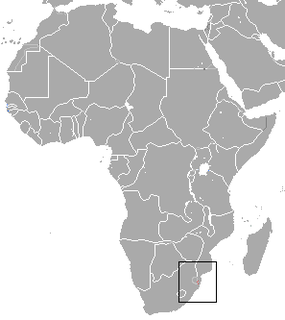
The giant ibis, the only species in the monotypic genus Thaumatibis, is a wading bird of the ibis family, Threskiornithidae. It is confined to northern Cambodia, with a few birds surviving in extreme southern Laos and a recent sighting in Yok Đôn National Park, Vietnam.

Juliana's golden mole is a golden mole endemic to South Africa. It is listed as an endangered species due to habitat loss and a restricted range. Golden moles are an ancient group of mammals that live mostly below ground. The eponymous Juliana is Juliana Meester, the wife of the South African zoologist who named this species.

The Utah prairie dog is the smallest species of prairie dog, a member of the squirrel family of rodents native to the south central steppes of the US state of Utah.

Ambystoma talpoideum, the mole salamander, is a species of salamander found in much of the eastern and central United States, from Florida to Texas, north to Illinois, east to Kentucky, with isolated populations in Virginia and Indiana. Older sources often refer to this species as the tadpole salamander because some individuals remain in a neotenic state. This salamander lives among the leaf litter on the forest floor, migrating to ponds to breed.

Gunning's golden mole is a small mammal endemic to South Africa. It was listed in 2006 as an endangered species. Its decreasing numbers are due to habitat clearance or destruction and predation from domesticated cats and dogs. It is a burrowing animal and spends the majority of its time underground.

The giant golden mole(Chrysospalax trevelyani) is a small mammal found in Africa. At 23 centimetres (9.1 in) in length, it is the largest of the golden mole species. The mole has dark, glossy brown fur; the name golden comes from the Greek word for green-gold, the family Chrysochloridae name.

The white-eared night heron is a species of heron in the family Ardeidae. It is found in southern China and northern Vietnam. IN 2018, it has been also reported from Valmiki National Park, India. It is threatened by habitat loss and habitat fragmentation.

Marley's golden mole is a species of burrowing mammal in the golden mole family, Chrysochloridae. It is found in South Africa and possibly Eswatini. It has been separated from Amblysomus hottentotus by Bronner. Its natural habitat is indigenous forests and moist grassland, and also gardens. It is classified as Endangered in the IUCN Red List of Threatened Species. The main threats it faces are habitat degradation, either through overgrazing by cattle or the removal of vegetation for firewood, and urbanization.

The big-headed African mole rat,, also known as the giant root-rat, Ethiopian African mole rat, or giant mole rat, is a rodent species in the family Spalacidae. It is endemic to Ethiopia's Bale Mountains. Its natural habitat is subtropical or tropical high-altitude grassland, where it can reach densities of up to 2,600 individuals per square kilometre. It is threatened by habitat loss. Where the two species overlap, it is the main prey of the endangered Ethiopian wolf.

The greater Chinese mole is a species of mammal in the family Talpidae. It is found in China and potentially Myanmar.

Euroscaptor is a genus of mammal in the family Talpidae. Members are found in China and South & Southeast Asia. It contains the following species as of October 2021:

The long-nosed mole is a species of mammal in the family Talpidae. It is endemic to China, where it has a widespread distribution.

The Himalayan mole or short-tailed mole is a species of mammal in the family Talpidae.

The Japanese mountain mole is a species of Old World mole in the family Talpidae. It is endemic to Japan. It is the only member of the monotypic genus Oreoscaptor. Its natural habitats are temperate forests and temperate grassland.

Talpini is a tribe of mammals known as Old World Moles. It is a division of the subfamily Talpinae.

An endangered species is a species that is very likely to become extinct in the near future, either worldwide or in a particular political jurisdiction. Endangered species may be at risk due to factors such as habitat loss, poaching and invasive species. The International Union for Conservation of Nature (IUCN) Red List lists the global conservation status of many species, and various other agencies assess the status of species within particular areas. Many nations have laws that protect conservation-reliant species which, for example, forbid hunting, restrict land development, or create protected areas. Some endangered species are the target of extensive conservation efforts such as captive breeding and habitat restoration.

The Vietnamese mole is a species of talpine mole found in Vietnam.

The Ngoc Linh mole is a species of mammal in the family Talpidae. It is endemic to central Vietnam. It was named after Ngọc Linh mountain, which it was first discovered in the vicinity of.


















